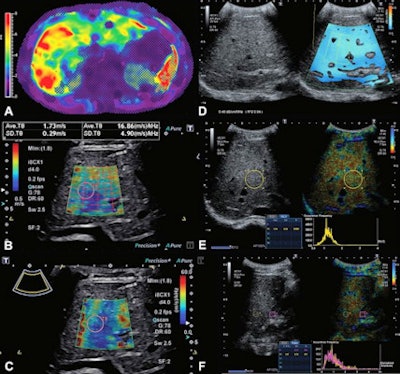
Ultrasound shear-wave elastography can correlate well with MR elastography for measuring liver stiffness in children and young adults with known or suspected liver disease, said researchers who published their results May 24 in Radiology.
Researchers led by Dr. Vinicius Alves from the Cincinnati Children's Hospital Medical Center in Ohio examined a variety of ultrasound shear-wave metrics in comparison to MR elastography-derived stiffness. Of them, they found that measuring the speed of the ultrasound shear wave as it moves through tissue correlated best with MRI in predicting abnormal liver shear stiffness.
"Our study provides important data on the diagnostic performance of quantitative ultrasound in children with chronic liver disease, using MRI as a reference standard," Alves and colleagues wrote.
Pediatric chronic liver disease may have several causes. Previous research shows that nonalcoholic fatty liver disease is the most common cause of liver disease in children. The common pathway of these diseases is fibrosis, cirrhosis, and liver failure.
Liver biopsy is the standard for diagnosing and defining the severity of liver disease cases. However, research in recent years has touted the promise of using imaging methods such as MRI and ultrasound, which don't use ionizing radiation, to characterize disease severity in children and young adults.
While the use of quantitative MRI and ultrasound have increased in evaluating liver disease, there is not much data comparing the modalities. The researchers added that current data is "largely related" to elastography.
Alves et al wanted to find out the associations between quantitative ultrasound and MRI liver measures in children, adolescents, and young adults with liver disease. They also wanted to define the predictive ability of quantitative ultrasound measures to detect abnormal liver stiffening and steatosis defined with MRI.
The study authors looked at data from 44 study participants with an age range of 8 to 21 years. Along with having known or suspected liver disease, the participants had a body mass index (BMI) less than 35 kg/m2.
 Images show MR elastography and quantitative ultrasound images in 16-year-old boy with Fontan-associated liver disease and elevated liver shear stiffness (5.4 kPa with gradient-recalled echo MR elastography). (A) Axial MR elastogram with 95% confidence map overlay shows a stiff (5.4 kPa) heterogeneous liver. Image colors indicate stiffness (in kPa) according to the scale left of the elastogram image. (B) A transverse 2D shear-wave elastography ultrasound image with shear-wave speed of 1.73 m/sec (9 kPa). (C) A transverse shear-wave dispersion map with dispersion of 16.86 m/sec/kHz. (D) A split-screen transverse image shows a liver attenuation measurement of 0.46 dB/cm/MHz. (E) A split-screen transverse image shows a normalized local variance measurement of 1.24. (F) A split-screen longitudinal image shows a hepatorenal index measurement of 1.07. Images courtesy of RSNA.
Images show MR elastography and quantitative ultrasound images in 16-year-old boy with Fontan-associated liver disease and elevated liver shear stiffness (5.4 kPa with gradient-recalled echo MR elastography). (A) Axial MR elastogram with 95% confidence map overlay shows a stiff (5.4 kPa) heterogeneous liver. Image colors indicate stiffness (in kPa) according to the scale left of the elastogram image. (B) A transverse 2D shear-wave elastography ultrasound image with shear-wave speed of 1.73 m/sec (9 kPa). (C) A transverse shear-wave dispersion map with dispersion of 16.86 m/sec/kHz. (D) A split-screen transverse image shows a liver attenuation measurement of 0.46 dB/cm/MHz. (E) A split-screen transverse image shows a normalized local variance measurement of 1.24. (F) A split-screen longitudinal image shows a hepatorenal index measurement of 1.07. Images courtesy of RSNA.MRI scans were performed on a 1.5-tesla scanner (Ingenia, Philips). Ultrasound scans were performed immediately afterward (Aplio i800, Canon Medical Systems USA). The team found that ultrasound shear-wave speed and MR elastography-derived stiffness had a positive correlation of 0.73 (p = 0.001).
Shear-wave speed also had an area under the receiving operating curve (AUC) of 0.95 for predicting abnormal liver stiffness with MR elastography. The researchers added that ultrasonic attenuation had an AUC of 0.75 for predicting abnormal liver MRI proton density fat fraction.
The authors wrote that their findings warrant discussion and that future research is needed for validation, as well as evaluating the predictive performance of these ultrasonic measures across different system manufacturers.
"Ultrasonic shear-wave dispersion is thought to reflect tissue viscosity, a characteristic different from, but related to, tissue stiffness," they wrote. "There is some thought that changes in viscosity may be reflective of inflammation, potentially allowing the separation of inflammation from fibrosis in diseased liver. However, in our study, liver shear-wave speed and shear-wave dispersion were correlated."



.fFmgij6Hin.png?auto=compress%2Cformat&fit=crop&h=100&q=70&w=100)





.fFmgij6Hin.png?auto=compress%2Cformat&fit=crop&h=167&q=70&w=250)











